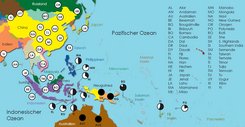Many roads lead to Asia
Contrary to what was previously assumed, modern humans may have populated Asia in more than one migration wave
The discovery by Russian archaeologists of the remains of an extinct prehistoric human during the excavation of Denisova Cave in Southern Siberia in 2008 was nothing short of a scientific sensation. The sequencing of the nuclear genome taken from an over 30,000-year-old finger bone revealed that Denisova man was neither a Neanderthal nor modern human, but a new form of hominin. Minute traces of the Denisova genome are still found in some individuals living today. The comparisons of the DNA of modern humans and prehistoric human species provide new indications of how human populations settled in Asia over 44,000 years ago.

As scientists from Harvard Medical School in Boston (USA) and the Max Planck Institute for Evolutionary Anthropology in Leipzig have discovered, the Denisova hominin passed on genetic material not only to populations that live in New Guinea today, but also to Australian aborigines and population groups in the Philippines. David Reich, professor of Genetics at Harvard Medical School, says: “The Denisovan DNA is comparable to a medical contrast agent that can be used to make a person’s blood vessels visible. It has such a high recognition value that even small volumes can be detected in individuals. Therefore, we were able to track down Denisovan DNA in human dispersals. The sequencing of prehistoric DNA is an important tool for researching human evolution.” The scientists have discovered that, contrary to the information available up to now, modern humans possibly populated Asia in at least two migration waves. According to David Reich, the original inhabitants who still populate Southeast Asia and Oceania today came from the first migration wave. Later migrations formed populations in East Asia that are related to the population found in Southeast Asia today.
Accordingly, Denisova hominins were spread across an extraordinarily large ecological and geographical area extending from Siberia to tropical Southeast Asia. “The fact that Denisovan DNA can be detected in some but not other original inhabitant populations living in Southeast Asia today shows that numerous populations with and without Denisovan DNA existed over 44,000 years ago,” says Mark Stoneking, professor at the Department of Evolutionary Genetics at the Max Planck Institute for Evolutionary Anthropology and leading author of the study. “The simplest explanation for the presence of Denisovan genetic material in some but not all groups is that Denisova people themselves lived in Southeast Asia.” In December 2010, Svante Pääbo from the Max Planck Institute for Evolutionary Anthropology reported in the journal Nature that Denisova hominins contributed genes to human populations living in New Guinea today.

Genetic footprint
The new study, which was initiated by Mark Stoneking – an expert in the field of human genetic variation in Southeast Asia and Oceania – is now researching the genetic footprint that the Denisova hominin has left behind in us modern humans. The scientists analysed the genomes of 33 populations living in Southeast Asia and Oceania today, including people from Borneo, Fiji, Indonesia, Malaysia, Australia, the Philippines, Papua New Guinea and Polynesia. Some of this data were already available and others were recorded in the context of the current study.
The analysis carried out by the researchers shows that the Denisova hominin contributed genetic material not only to the people living in New Guinea today but also to Australian aborigines, the Mamanwa, a Philippine “Negrito” group, and some other populations in eastern Southeast Asia and Oceania. In contrast, western and northwestern groups, including other “Negrito” groups, such as the Onge people who inhabit the Andaman Islands and the Jehai of Malaysia, and the mainland East Asians did not mix with the Denisova people.
The researchers conclude from this that Denisova hominins interbred with modern humans at least 44,000 years ago, before the Australians and inhabitants of New Guinea separated from each other. As opposed to this, Southeast Asia was first colonised by modern humans who were not related to today’s Chinese and Indonesian populations. The latter arrived in the course of subsequent migratory movements. This hypothesis on the settlement of Southeast Asia and Oceania, which is referred to as the “South Route” has already been substantiated by archaeological finds. However, strong support in the form of genetic evidence has yet to be found.
Scientists from the USA, Germany, India, Taiwan, Japan, Malaysia and the Netherlands contributed to this study, which was financed by the Max Planck Society and the US National Science Foundation’s HOMINID Program.













